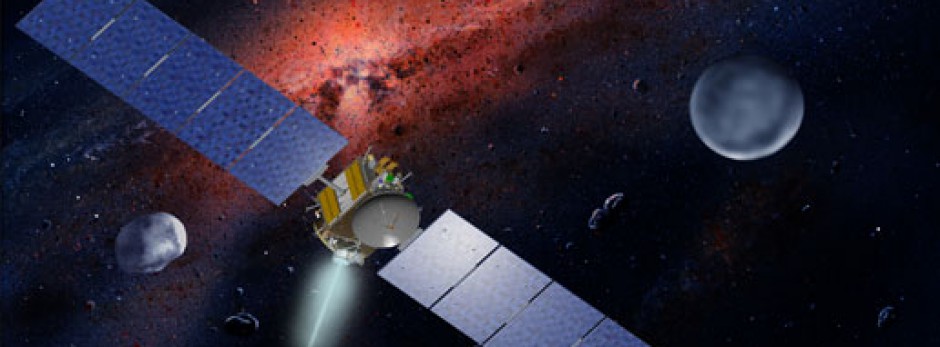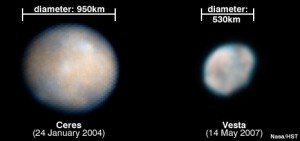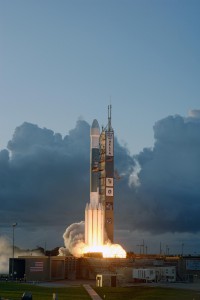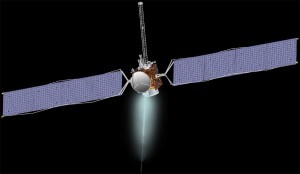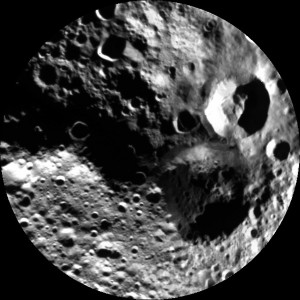
The mission Dawn will help us characterize and identify the early processes of our solar system and what dominated its formation. We have learned that the materials from our solar system vary with their distance from the sun, thus forming the Terrestrial planets closer to the sun and Jovian planets father away. In between the Terrestrial and Jovian planets lies an asteroid belt where the asteroid Vesta and the dwarf planet Ceres lie. Dawn was selected to orbit Vesta and Ceres because they show more characterization of formation from our solar system and it helps us better understand it. While Vesta and Ceres lie close to each other in the asteroid belt, they are strikingly different. Vesta is dry with a resurfacing surface and Ceres contains water bearing minerals and can possibly possess a weak atmosphere.
→Vesta and Ceres
Vesta:
- It was discovered on March 29, 1807 by Heinrich Wilhelm Olbers
- Dimensions: About 578 by 560 by 458 kilometers, about the length of Arizona
- Its shape is nearly spheroid, with a massive chunk out of the south pole
- Rotates once every 5 hours, 20 minutes
- Was formed 4.5 billion years ago
- Its shows that shortly after it was formed it oozed lava which froze over the years
- Vesta has 2,000 craters recorded by Dawn
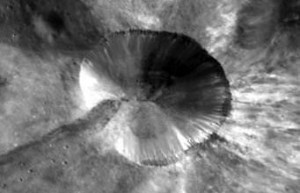
 →Vesta’s Layers
→Vesta’s Layers
→ Canuleia- meteor impact crater on Vesta
Canuleia is about 6 miles in diameter. According to Dawns discoveries, it has a lot of bright streaks as shown in the picture above. Conuleia is characterized as young surface.
Ceres
- It was discovered January 1,1801 by Giuseppe Piazzi
- It is the first asteroid/dwarf planet discovered
- Size: 975 by 909 kilometers (606 by 565 miles) it is as big across as Texas
- Shape: Spheroid
- It rotates once every 9 hours, 4.5 minutes
- Just like Earth it had dense material at the core and lighter minerals near the surface
- Astronomers believe that there is water underneath the crust because it is denser the Earths crust.

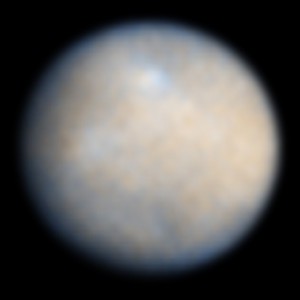
Ceres view from Hubble Telescope
Dawn and its Launch
Key Spacecraft Characteristics:
- Extensive redundancy using flight-proven assemblies from other Orbital and JPL spacecraft
- Ion propulsion system, based on the design validated on Deep Space 1
- Two 100 W (RF) traveling wave tube amplifiers, fixed 1.5 m high-gain antenna, 3 low-gain antennas, two small deep space transponders
- Solar array capable of producing more than 10 kW at Earth’s distance from the Sun and more than 1 kW at Ceres’s maximum distance
- Flight proven attitude control system used on Orbview, TOPEX/Poseidon ocean topography mission, and Far Ultraviolet Spectroscopic Explorer
- Simple hydrazine reaction control subsystem with two sets of six 0.9 N engines used on the Indostar spacecraft
- Command and data handling uses off the shelf components as used on the Orbview program
- Modular flight software based on design used on Orbview
- Core structure is graphite composite. Panels are aluminum core, some with aluminum facesheets and others with composite facesheets.
(information from: http://dawn.jpl.nasa.gov/mission/spacecraft.asp)
Dawn is a mission owned by NASA’s Discovery Program. Its journey to the asteroid belt was launched successfully on September 27th, 2007 at Cape Canaveral Air Force Station in Florida. It is the first space craft to orbit two It traveled towards Vesta and had a gravitational assist from Mars February 2009. It arrived around Vesta July 2011 where it took clear photographs that were used to examine the different properties of Vesta that gave us signs of water and other useful information that helped us determine the workings of the beginning of our solar system. It captured a meteorite as a sample of the crust of Vesta. Scientists uncovered a lot of useful information from that sample. It departed from Vesta July 2o12. From there it headed towards Ceres and its planned arrival is February 2015. The first mission will end July 2015.
This is a simulated path of Dawn on its arrival and departure from Vesta and its path towards Ceres.
There are three main reasons for this mission. One: Dawn captures images of Vesta and Ceres that show the earliest moments of our solar system giving us hints on how these objects were formed. Two: Dawn shows us the nature of the building blocks that built the terrestrial planets which help us improve our understanding of them. An three: it compares and contrasts the formation and evolution of Vesta and Ceres who followed to different evolutionary paths and that will help us understand what controls evolution. While Dawn collects information on Vesta and Ceres, it gives us missing pieces of the investigation of Mercury, Mars, and Earth.
According to an article by Kenneth Chang, while Dawn was orbiting around Vesta it discovered that its surface it as bright as snow in some parts and dark as coals in other parts. Scientists believe that its dark spots may have been caused by high speed impacts melting or recent volcanic activity. Because of the amount of dark spots on Vesta scientist think that about 300 steroids likely hit Vesta after its formation more that 3.5 Its iron core may have had a magnetic field when Vesta was first formed, more than 3.5 billion years ago. “After Vesta formed, the gravity of newly formed Jupiter stopped further growth. The traditional view is that Jupiter’s pull accelerated the Vesta-size asteroids so that they smashed themselves apart instead of gently coming together. Jupiter would have scattered away many of the original asteroids, but slowly.” (Chang, Kenneth. “Observations of an Asteroid Provide Hints of How the Earth Came Together”.New York Times. May 10, 2012. http://www.nytimes.com/2012/05/11/science/space/asteroid-vesta-proves-to-be-dwarf-planet.html?_r=0). From the information received from Dawn, scientists have unraveled that a form of meteorites that have been found on Earth come from Vesta.
This is an image of the northern and southern hemisphere of Vesta. The left side of the picture shows the northern hemisphere. The right side shows the southern hemisphere. The different colors represent the distance to Vesta’s center. The surfaces’ high and lows range from -13.82 miles, that being the lowest point, and 27.48 miles high. The violet means it’s low and the red means it’s high. There is a mountain on the South Pole of Vesta that is two times the size of Mount Everest and it is inside the largest impact crater which you can see on the right side of the picture.
There were a lot of new interesting information unraveled by sending Dawn to orbit Vesta. Its taken us a step closer to figuring out the mystery that is our solar system. Lets wait and see what Ceres can show us.
Here are some videos on Dawns progress:
Dawns orbit around Vesta and Ceres
<iframe width=”560″ height=”315″ src=”https://www.youtube.com/embed/MTfMBJngwtw” frameborder=”0″ allowfullscreen></iframe>
Dawn over Vesta
<iframe width=”560″ height=”315″ src=”https://www.youtube.com/embed/LhIBISTXLm8″ frameborder=”0″<allowfullscreen></iframe>
Here are some useful articles on the progress Dawn has made:
http://www.space.com/12321-nasa-spacecraft-orbits-asteroid-vesta-space-success.html
http://www.nytimes.com/2012/05/11/science/space/asteroid-vesta-proves-to-be-dwarf-planet.html?_r=0
http://www.nasa.gov/mission_pages/dawn/news/dawn-20090226.html
If you cannot see the videos, please click the links below:
https://www.youtube.com/watch?v=LhIBISTXLm8
https://www.youtube.com/watch?v=MTfMBJngwtw
Images are from www.google.com/images.
